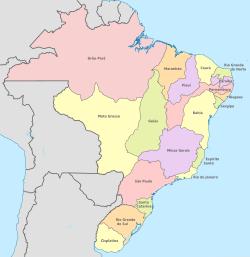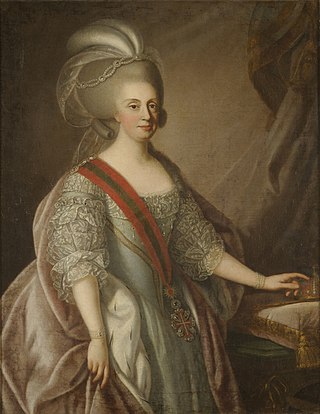
Dona Maria I was Queen of Portugal from 24 February 1777 until her death in 1816. Known as Maria the Pious in Portugal and Maria the Mad in Brazil, she was the first undisputed queen regnant of Portugal and the first monarch of Brazil.

The national flag of Brazil, is a blue disc depicting a starry sky spanned by a curved band inscribed with the national motto "Ordem e Progresso", within a yellow rhombus, on a green field. It was officially adopted on 19 November 1889 — four days after the Proclamation of the Republic, to replace the flag of the Empire of Brazil. The concept was the work of Raimundo Teixeira Mendes, with the collaboration of Miguel Lemos, Manuel Pereira Reis and Décio Villares.

The flag of Portugal is the national flag of the Portuguese Republic. It is a rectangular bicolour with a field divided into green on the hoist, and red on the fly. The lesser version of the national coat of arms of Portugal is centered over the colour boundary at equal distance from the upper and lower edges. Its presentation was done on 1 December 1910, after the downfall of the constitutional monarchy on 5 October 1910. However, it was only on 30 June 1911, that the official decree approving this flag as the official flag was published. This new national flag for the First Portuguese Republic, was selected by a special commission whose members included Columbano Bordalo Pinheiro, João Chagas and Abel Botelho. The conjugation of the new field color, especially the use of green, was not traditional in the Portuguese national flag's composition and represented a radical republican-inspired change that broke the bond with the former monarchical flag. Since a failed republican insurrection on 31 January 1891, red and green had been established as the colours of the Portuguese Republican Party and its associated movements, whose political prominence kept growing until it reached a culmination period following the Republican revolution of 5 October 1910. In the ensuing decades, these colours were popularly propagandised as representing the hope of the nation (green) and the blood of those who died defending it (red), to endow them with a more patriotic and dignified, therefore less political, sentiment.

The Most Serene House of Braganza, also known as the Brigantine dynasty, is a dynasty of emperors, kings, princes, and dukes of Portuguese origin which reigned in Europe and the Americas.

The coat of arms of Brazil was created on 19 November 1889, four days after Brazil became a republic. It consists of the central emblem surrounded by coffee and tobacco branches, which were important crops in Brazil at that time. In the round shield in the center, the Southern Cross can be seen. The ring of 27 stars around it represents Brazil's 26 states and the Federal District.

The House of Aviz, also known as the Joanine Dynasty, was a dynasty of Portuguese origin which flourished during the Renaissance and the period of the Portuguese discoveries, when Portugal expanded its power globally.

The coat of arms of Portugal is the main heraldic insignia of Portugal. The present model was officially adopted on 30 June 1911, along with the present model of the Flag of Portugal. It is based on the coat of arms used by the Kingdom of Portugal since the Middle Ages. The coat of arms of Portugal is popularly referred as the Quinas.
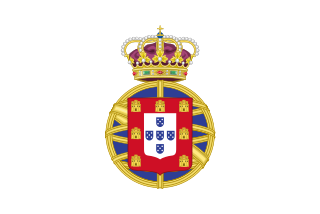
The United Kingdom of Portugal, Brazil and the Algarves was a pluricontinental monarchy formed by the elevation of the Portuguese colony named State of Brazil to the status of a kingdom and by the simultaneous union of that Kingdom of Brazil with the Kingdom of Portugal and the Kingdom of the Algarves, constituting a single state consisting of three kingdoms.
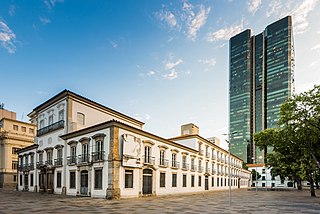
The Paço Imperial, or Imperial Palace, previously known as the Royal Palace of Rio de Janeiro and Palace of the Viceroys, is a historic building in the center of the city of Rio de Janeiro, Brazil. The Paço Imperial was built in the 18th century to serve as a residence for the governors of colonial Brazil. From 1808, it was used as a royal residence by King John VI of Portugal as King of Portugal and later also as King of Brazil. In 1822 it became the city palace of the monarchs of the Empire of Brazil, Pedro I and Pedro II, who used it not as a residence, but as a workplace. It was one of the main political centers of Brazil for nearly 150 years, from 1743 to 1889.

The Kingdom of Portugal was a monarchy in the western Iberian Peninsula and the predecessor of the modern Portuguese Republic. Existing to various extents between 1139 and 1910, it was also known as the Kingdom of Portugal and the Algarves after 1415, and as the United Kingdom of Portugal, Brazil and the Algarves between 1815 and 1822. The name is also often applied to the Portuguese Empire, the realm's overseas colonies.
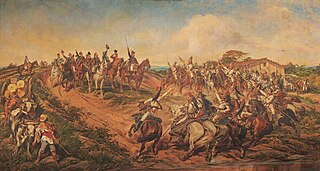
The independence of Brazil comprised a series of political and military events that led to the independence of the Kingdom of Brazil from the United Kingdom of Portugal, Brazil and the Algarves as the Brazilian Empire. It is celebrated on 7 September, the date when prince regent Pedro of Braganza declared the country's independence from the United Kingdom of Portugal, Brazil and the Algarves on the banks of the Ipiranga brook in 1822 on what became known as the Cry of Ipiranga. Formal recognition by Portugal came with the Treaty of Rio de Janeiro, signed in 1825.

The Portuguese royal court transferred from Lisbon to the Portuguese colony of Brazil in a strategic retreat of queen Maria I of Portugal, prince regent John, the Braganza royal family, its court, and senior officials, totaling nearly 10,000 people, on 27 November 1807. The embarkment took place on the 27th, but due to weather conditions, the ships were only able to depart on 29 November. The Braganza royal family departed for Brazil just days before Napoleonic forces invaded Portugal on 1 December 1807. The Portuguese crown remained in Brazil from 1808 until the Liberal Revolution of 1820 led to the return of John VI of Portugal on 26 April 1821.
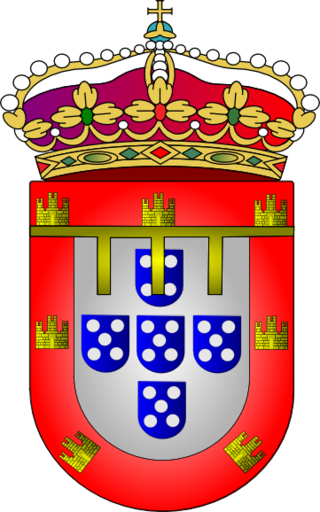
This is a list of Princesses Royal of Portugal. The title is, since 1815, carried either in her own right by the heiress to the throne, as a substantive title, or by the wife of the heir to the throne, the Prince Royal of Portugal, as a courtesy title. It was preceded by the titles Princess of Brazil and Princess of Portugal.

The Pantheon of the House of Braganza, also known as the Pantheon of the Braganzas, is the final resting place for many of the members of the House of Braganza, located in the Monastery of São Vicente de Fora in the Alfama district of Lisbon, Portugal. The pantheon's burials have included Portuguese monarchs, Brazilian monarchs, a Romanian monarch, queen consorts of Portugal, and notable Infantes of Portugal, among others.

The Sceptre of the Armillary, also known as the Sceptre of the United Kingdom of Portugal, Brazil, and the Algarves, is a piece of the Portuguese Crown Jewels, originally created for the acclamation of King João VI, alongside the Crown of João VI and the Mantle of João VI.

The Mantle of João VI, also known as the Mantle of the United Kingdom of Portugal, Brazil, and the Algarves, is the royal robe, a part of the Portuguese Crown Jewels, that was fashioned for the acclamation of King João VI, alongside the Crown of João VI and the Sceptre of the Armillary.

The Descendants of John VI of Portugal, of the House of Braganza, would play a role in Portuguese imperial affairs, global royalty, and major historical events of their time. John's marriage to Carlota Joaquina of Spain, which was not a content one, produced many children who became key players in the world at their time.
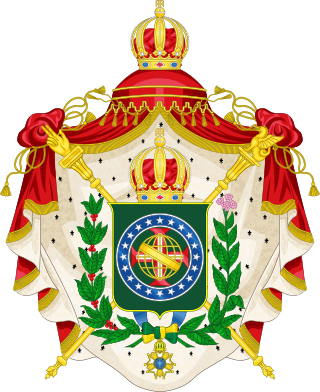
Brazilian heraldry as a distinct form of heraldry dates to 1822, when Brazil became independent as an Empire, under the reign of the House of Braganza. Being formerly a part of the Portuguese Empire and being ruled by the same Royal House that reigned in Portugal, Brazilian heraldry followed the tradition of Portuguese heraldry.
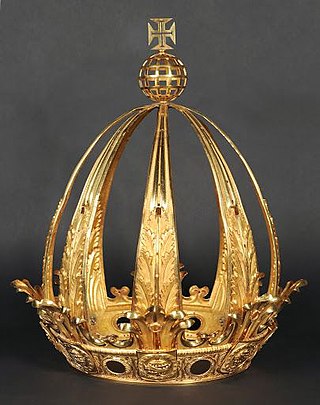
The crown of Pedro I is the first imperial crown of Brazil and was made for emperor Pedro I of Brazil. It was made in 1822 for his coronation and was the symbol and emblem of Brazilian imperial power until it was replaced in 1841 by the crown of his son and successor Pedro II. It is one of the jewels of the Brazilian Empire and is now on display at the Imperial Museum in Petrópolis.
